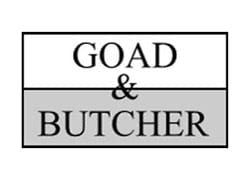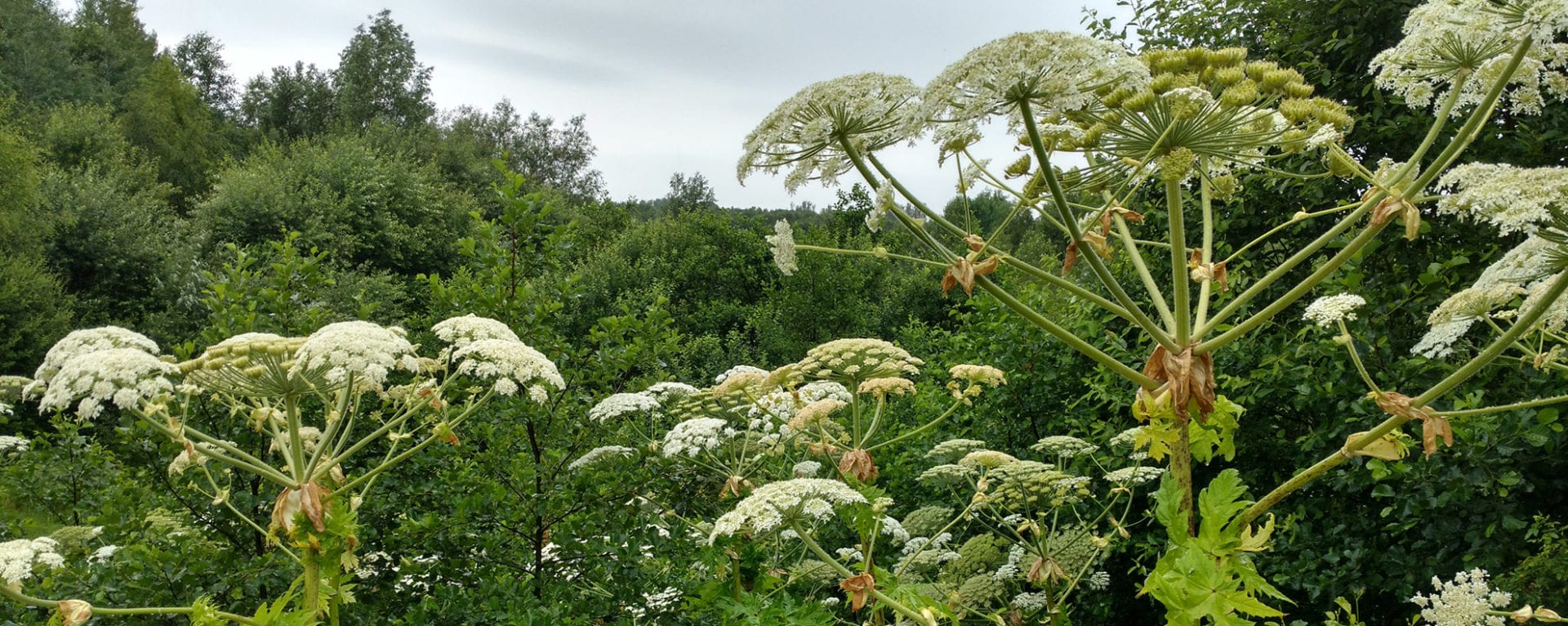What is Giant Hogweed?
Giant hogweed (Heracleum mantegazzianum), is part of the carrot family and very closely related to cow parsley. An invasive, non-native weed, it has aggressively spread throughout the UK, with attitudes towards the plant becoming highly negative, supported by numerous stories and myths. It is true, however, that giant hogweed can be very poisonous to humans and animals, with its sap capable of causing injury, including severe burns, blisters and irritation to skin. In extreme cases it has blinded people.
It was introduced to the UK in 1893 by the Victorians as an ornamental plant from the Caucasus region. Now, it has become one of the most successful and dangerous weeds growing on these shores. Infestations are most commonly found along riverbanks, footpaths, in parks and other public areas, although it is increasingly appearing in domestic gardens and commercial habitats.
The hogweed family (Heracleum) accounts for around 70 varieties around the world. With an attractive appearance, giant hogweed plants can reach up to 15 feet (5 metres) high, which make it relatively easy to identify. Hogweed flower heads are an upturned umbrella in shape and can reach up to 3 feet in diameter, producing lots of pollen and nectar for honeybees. A single plant can produce between 30,000-50,000 seeds. The leaves can grow to 6 feet across giving validation to the Latin name Heracleum.
After spreading throughout Russia, the leaves of the plant were added to soup or borsch in early spring. The shoots can be marinated, and the leaves salted for further use. The leaves are dried after soaking in water or alternatively boiled to remove etheric oil. The roots can even be used to produce sugar.
There is no legal obligation in the UK to remove or control giant hogweed when it is growing in your garden. That said, the plant is listed in the Schedule 9 Part II of the Wildlife and Countryside Act 1981, meaning that spreading it in the wild is an offence and one may be a subject to a penalty of up to £5000 or even imprisonment.
We can help you get rid of giant hogweed, safely and hassle free. Call us now:
0161 883 0666
Why Is Giant Hogweed Dangerous?
Its sap contains a photoactive toxic glucoside called furocoumarin, and can be found in the leaves, stems and seeds. Contact with the sap on human skin followed by exposure to sunlight can cause serious burning and may even be lethal to children if the exposed area is large enough. Interestingly, furocoumarins from other natural products such as celery, lime, coriander, carrots and parsley can make the skin sensitive to the UV fraction of sunlight.
Removal Options for Giant Hogweed
Giant hogweed is one of the most hazardous plants in the UK. Therefore, strict safety measures must be implemented when dealing with its dangers, and why we advise against DIY removal. It is a classified as controlled waste, meaning that it cannot be disposed of in your garden or general waste bin, nor will it be accepted at your local tip/household waste recycling centre.
We strongly recommend contacting dedicated contractors for the disposal of giant hogweed. Like Japanese knotweed, giant hogweed can be eliminated by physical removal or by applying chemicals. As a company which specialises in the eradication of a range of invasive weeds, Japanese Knotweed Plus Ltd will kill giant hogweed by physically removing or treating it with herbicides, depending on your particular case.
We are based in Oldham, but cover the whole of Greater Manchester, Cheshire and Lancashire. Get in touch with us on 0161 883 0666 for a free, no obligation quote.
Cutting the upturned umbrella-shaped flower before they go to seed
This is the most effective way to eradicate hogweed in small areas. However, this is also one of the most dangerous methods due to the possibility of splashing sap onto unprotected skin. If the correct time for trimming buds or flowers has been missed, special attention should be given to prevent the growth of new side-shoot umbrellas from the main rosette. Otherwise, once the plant has produced new umbrellas with flowers in their ovaries there will be a new generation of seeds, enough to restore the hogweed thicket.
Incineration
Incineration is an effective way to destroy the maturing seeds and should be undertaken before the ripening process in the central largest umbrella is complete. This method requires care and accuracy, as during burning, the umbrellas become flammable due to the oils in the seeds. The use of this technique may not be permitted in residential areas.
Treatment with herbicide
Be aware, the use of different types of approved herbicides is now only allowed by accredited specialists. Since 26 November 2015, operation under the Grandfathers Rights exemption is no longer allowed. Operators applying professional herbicide must possess UK recognised certification. This certificate is also required to purchase these chemical products.
Our fully qualified, professional operatives are obliged to contact the Environment Agency if treatments are to be carried out near to waterways.
Mowing
This is an effective way to destroy hogweed but only before flowering. This must be repeated no later than 3-4 weeks after the first mowing. This technique is necessary to destroy all the generative shoots bearing inflorescences and the flowers accordingly. It is important to prevent hogweed from blooming and from forming new seeds. If hogweed was mowed only once in the middle of flowering it will only contribute to further proliferation of plants.
Do immediately contact your doctor or nearest A&E department if you are accidentally exposed to the sap of Giant Hogweed.
Do Rinse the affected skin as soon as possible with cold running water and gently cover the area from the UV light of the sun (UV light will not pass through ordinary window glass).
Do Use liquids containing alcohol for rinsing the affected areas (DO NOT RUB).
Do carry out all the measures traditionally prescribed for skin burns. This means that you mustn’t use any fixed bandages.
Don’t Mow hogweed between the end of flowering and early seeds set. This will not have the desired effect unless you are planning on destroying the crop immediately after mowing it. Any hogweed that has been cut down must be removed immediately in a heap and burned. This is one of the most efficient ways to destroy the seeds.
Don’t Leave the cut-down hogweed in situ. Even after it has been cut down, the main umbrella stem of the hogweed stores large supplies of nutrients enough to provide the seeds to germinate, ripen and give life to new plants.
Don’t Mow hogweed which is shedding seeds. This will just lead to a greater dispersion of hogweed. If the umbrellas with ripe seeds are cut, especially in windy conditions it will help spread the seeds to new areas.
Don’t Deal with hogweed without protective clothing. Waterproof clothing is strongly recommended, as a plant sap may penetrate through ordinary clothes and touch the skin. If the sap comes into contact with human skin and is not washed off within 24 hours it will result in burns.
Discover Our Valued Customers



















